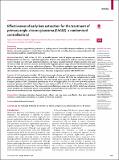Effectiveness of early lens extraction for the treatment of primary angle-closure glaucoma (EAGLE) : a randomised controlled trial
Abstract
Background . Primary angle-closure glaucoma is a leading cause of irreversible blindness worldwide. In early-stage disease, intraocular pressure is raised without visual loss. Because the crystalline lens has a major mechanistic role, lens extraction might be a useful initial treatment. Methods . From Jan 8, 2009, to Dec 28, 2011, we enrolled patients from 30 hospital eye services in five countries. Randomisation was done by a web-based application. Patients were assigned to undergo clear-lens extraction or receive standard care with laser peripheral iridotomy and topical medical treatment. Eligible patients were aged 50 years or older, did not have cataracts, and had newly diagnosed primary angle closure with intraocular pressure 30 mm Hg or greater or primary angle-closure glaucoma. The co-primary endpoints were patient-reported health status, intraocular pressure, and incremental cost-effectiveness ratio per quality-adjusted life-year gained 36 months after treatment. Analysis was by intention to treat. This study is registered, number ISRCTN44464607. Findings . Of 419 participants enrolled, 155 had primary angle closure and 263 primary angle-closure glaucoma. 208 were assigned to clear-lens extraction and 211 to standard care, of whom 351 (84%) had complete data on health status and 366 (87%) on intraocular pressure. The mean health status score (0·87 [SD 0·12]), assessed with the European Quality of Life-5 Dimensions questionnaire, was 0·052 higher (95% CI 0·015–0·088, p=0·005) and mean intraocular pressure (16·6 [SD 3·5] mm Hg) 1·18 mm Hg lower (95% CI –1·99 to –0·38, p=0·004) after clear-lens extraction than after standard care. The incremental cost-effectiveness ratio was £14 284 for initial lens extraction versus standard care. Irreversible loss of vision occurred in one participant who underwent clear-lens extraction and three who received standard care. No patients had serious adverse events. Interpretation . Clear-lens extraction showed greater efficacy and was more cost-effective than laser peripheral iridotomy, and should be considered as an option for first-line treatment.
Citation
Azuara-Blanco , A , Burr , J , Ramsay , C , Cooper , D , Foster , P J , Friedman , D S , Scotland , G , Javanbakht , M , Cochrane , C , Norrie , J & EAGLE study group 2016 , ' Effectiveness of early lens extraction for the treatment of primary angle-closure glaucoma (EAGLE) : a randomised controlled trial ' , Lancet , vol. 388 , no. 10052 , pp. 1389-1397 . https://doi.org/10.1016/S0140-6736(16)30956-4
Publication
Lancet
Status
Peer reviewed
ISSN
0140-6736Type
Journal article
Description
PJF is supported by salary funding from the National Institute for Health Research (NIHR) through a grant to the Biomedical Research Centre at Moorfields Eye Hospital and UCL Institute of Ophthalmology. This work is supported by the Medical Research Council (MRC G0701604) and funding is managed by the NIHR (NIHR-EME 09-800-26) on behalf of the MRC–NIHR partnership.Collections
Items in the St Andrews Research Repository are protected by copyright, with all rights reserved, unless otherwise indicated.

